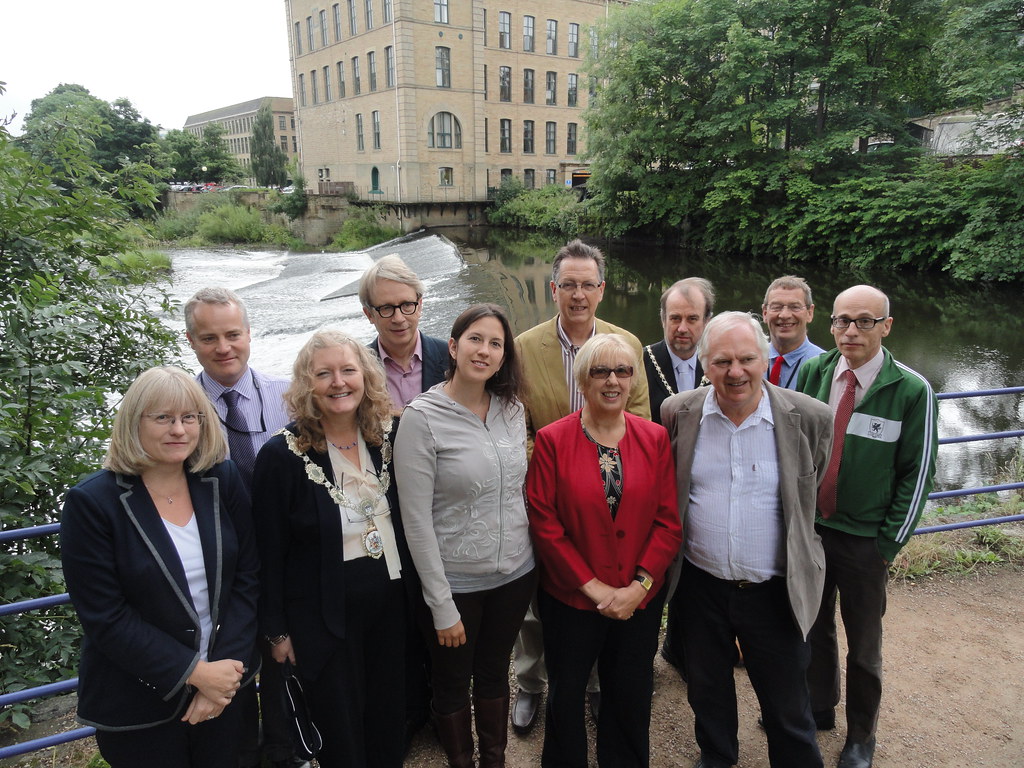Saltaire, Bradford
Category: The Great Neighbourhood Award 2014
Date of Visit: 2013
Learning Moments
The coincidence of the reopening of the redundant railway to create the Metro in 1985, with Jonathan Silver’s acquisition of the Salt’s Mill in 1987, has ensured that this neighbourhood can support economic as well as heritage regeneration.
In Saltaire, these are the NHS Trust offices in New Mill, PACE and Shipley College as well as income-generating visitor attractions that support local businesses. Saltaire has managed not to be an industrial heritage museum, but a thriving, economically and socially sustainable neighbourhood with the benefit of an industrial heritage.
The significant location of Shipley College in the area highlights the positive effect of the environment on learning for students. In addition students make a contribution to the diversity of the neighbourhood and to the maintenance of public space and helps support local retail businesses.
Saltaire is small enough to work as a coherent neighbourhood, to generate a community spirit and support a range of social facilities and events. Ironically, Salt’s Victorian patronage and his ambition that: “Throughout the village, cleanliness, cheerfulness and order must reign supreme” has some contemporary resonance. People who buy into the Saltaire lifestyle appear proud and happy within their community.
Although, in some cases, the real value of this designation can be questioned, in Saltaire it has been a catalyst for community to take pride in the environment and buildings and to stimulate higher management standards, such as the appointment of a project officer and the formation of a high level steering group with a strong interest in strategic planning for the area. In addition it also confers a status that attracts visitors to the industrial heritage and cultural facilities.
Assessment Summary
Saltaire was built as an industrial village in the 1850s for workers in Titus Salt’s worsted factory. In its time it ensured that factory workers had good housing, working and living conditions and, because of this, it is a key moment in the history and values of urban planning. Saltaire is now a suburb of Bradford and is a highly desirable area to live for people working in Bradford and Leeds with over 70% of the properties owner occupied. It is also an international visitor destination with its restored industrial heritage and David Hockney gallery.
The majority of the area is both a conservation area and within a UNESCO World Heritage Site, and the industrial buildings, houses, public realm and open space are managed within the restrictions of these designations. Roberts Park has been restored with Heritage Lottery funding and is one of Bradford’s premier parks.
The coincidence of the reopening of a redundant railway to create the excellent Metro service in 1985, combined with the entrepreneur Jonathan Silver’s acquisition of the Salt’s Mill in 1987, ensured that this neighbourhood can support economic as well as heritage regeneration and that it has permanent links to Leeds and Bradford.
A sensitive but practical retention of key historic industrial and community buildings has created new sustainable uses, including the NHS Trust offices in New Mill, the leading technology company PACE and Shipley College as well as income-generating visitor attractions that support local businesses. Saltaire is not overwhelmed by its heritage value and has managed not to be just an industrial heritage museum and tourist attraction, but a thriving and sustainable neighbourhood.
Scale is important and as a relatively small and discrete settlement, Saltaire is able to work as a coherent neighbourhood, generating real community spirit and supporting a range of social facilities, independent retail businesses and events. Education is both an economic and social driver and the significant location of Shipley College in the area means that students can make a contribution to the diversity of the neighbourhood, to the practical maintenance of public space, as well as helping to support local retail businesses. As a bonus, the quality of the environment has a positive impact on learning for students.
Although in some places the real value of a World Heritage Site designation can be questioned, in Saltaire it has been a catalyst for the community to take pride in the environment and buildings, and has stimulated higher management standards, such as the appointment of a project officer and the formation of a high level public and private sector steering group with a strong interest in strategic planning for the area. In addition, it also confers a status that attracts visitors to the industrial heritage and cultural facilities.
When establishing Saltaire, Sir Titus Salt established a set of rules for his workers. One of his intentions was that: “Throughout the village, cleanliness, cheerfulness and order must reign supreme”. This has contemporary resonance – the people who buy into the Saltaire lifestyle are proud and happy within their community and neighbourhood, and it shows.
[mappress mapid=”12″]
